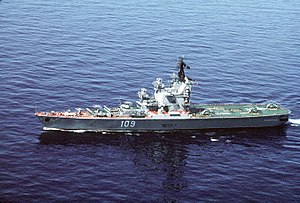Moskva class helicopter carrier

Leningrad underway in 1990.
|
|
| Class overview | |
|---|---|
| Name: | Moskva class |
| Operators: | |
| Succeeded by: | Kiev class |
| In service: | 1967–1991 |
| Planned: | 3 |
| Completed: | 2 |
| Cancelled: | 1 |
| Retired: | 2 |
| General characteristics | |
| Type: | Helicopter carrier |
| Displacement: |
|
| Length: | 196.6 m (645 ft) |
| Beam: | 35 m (115 ft) |
| Draught: | 7.6 m (25 ft) |
| Propulsion: | 2 shaft steam turbines, 4 pressure fire boilers, 75,000 kW (100,000 hp) |
| Speed: | 31 knots (57 km/h) |
| Range: | 14,000 nautical miles (25,928 km) at 12 knots (22 km/h) |
| Complement: | 850 |
| Armament: |
|
| Aircraft carried: | 18× Kamov Ka-25 'Hormone' or Mi-8 helicopters |
The Moskva-class helicopter carriers were the first operational Soviet Navy aircraft carriers, called helicopter carriers by the Soviet Navy. The Soviet designation was Project 1123 Kondor.
These ships were laid down at Nikolayev South (Shipyard No.444). The lead vessel was launched in 1965 and named Moskva; she entered commission two years later. Moskva was followed by Leningrad, which was commissioned in late 1968; there were no further vessels built, reportedly due to the poor handling of the ships in rough seas. Both were conventionally powered.
The Moskvas were not true "aircraft carriers" in that they did not carry any fixed-wing aircraft; the air wing was composed entirely of helicopters. They were designed primarily as anti-submarine warfare (ASW) vessels, and her weapons and sensor suite was optimized against the nuclear submarine threat. Their strategic role was to defend the Soviet ballistic missile submarine bastions against incursions by Western attack submarines, forming the flagships of an ASW task force.
The operational requirement was issued by Admiral Sergey Gorshkov in 1959. The aim of the ships was to counter NATO Polaris submarines and act as a flagship for anti-submarine warfare. Initially it was hoped to operate 10 helicopters from an 8000 ton ship. The design evolved into a larger vessel capable of operating up to 14 helicopters with self defence armament.
Shipboard ASW armament included a twin SUW-N-1 launcher capable of delivering a FRAS-1 projectile carrying a 450-millimetre (18 in) torpedo (or a 5 kiloton nuclear warhead); a pair of RBU-6000 ASW mortars; and a set of torpedo tubes. For self-defence, the Moskvas had two twin SA-N-3 surface-to-air missile (SAM) launchers with reloads for a total of 48 surface-to-air missiles, along with two twin 57 mm (2.2 in)/80 guns.
...
Wikipedia
